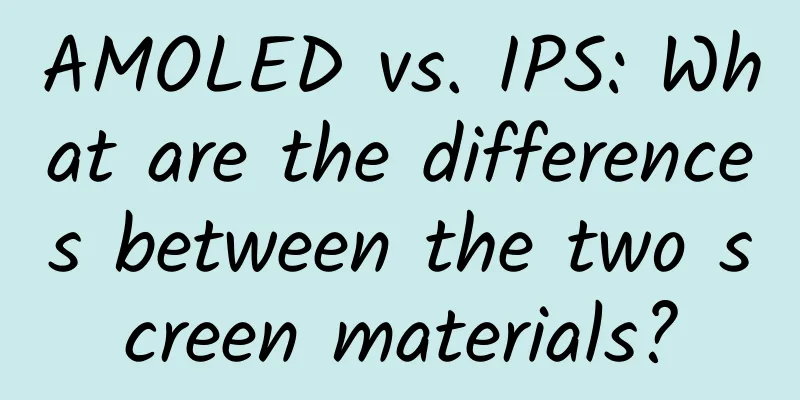AMOLED vs. IPS: What are the differences between the two screen materials?

|
When it comes to smartphones and tablets, the screen features are obviously what users are concerned about. In addition to size and resolution, the key to determining the display effect is obviously the screen material. Basically, the mainstream technologies in the current market include LCD (liquid crystal) and OLED (organic light-emitting diode), from which IPS panel technology and AMOLED (active matrix organic light-emitting diode) are derived. So, what is the difference between the display effects of the two screens? Let's discuss it together. IPS is brighter and has a wider angle, while AMOLED is more vivid and more energy-efficient First of all, IPS is a panel technology, and its essence is still LCD, which is what we often call liquid crystal screen. The advantage of IPS technology is that it improves the slow response speed of liquid crystal, enhances color performance, and brings a wider viewing angle. In terms of products, mainstream manufacturers including Apple , LG , HTC , etc. all use IPS on mobile devices. Interestingly, LG mainly promotes OLED in the field of television, but insists on using IPS for mobile devices, while its competitor Samsung is just the opposite. AMOLED is an improved version of OLED, and Samsung's Super AMOLED is one of its derivatives. Compared with LCD screens, AMOLED continues the characteristics of OLED's black performance and stronger contrast, while improving brightness and saving more power. Samsung has further optimized Super AMOLED on this basis, including calibrating the color gamut and increasing brightness. The performance of its latest model S6 has been greatly improved compared to before. In fact, through comparison, it is not difficult to find that AMOLED screens have brighter display effects and warmer tones than IPS, and are relatively more power-efficient, but the disadvantage is that the reading effect under sunlight is still unsatisfactory; IPS has higher brightness, better sunlight readability and display angle, but it consumes more power, and the cooler color effect will also make black and white images slightly bluish. Of course, for many insensitive users, the two screen materials may not be much different. They are also constantly developing to make up for their own shortcomings. How to choose may depend more on one's own preferences. As a winner of Toutiao's Qingyun Plan and Baijiahao's Bai+ Plan, the 2019 Baidu Digital Author of the Year, the Baijiahao's Most Popular Author in the Technology Field, the 2019 Sogou Technology and Culture Author, and the 2021 Baijiahao Quarterly Influential Creator, he has won many awards, including the 2013 Sohu Best Industry Media Person, the 2015 China New Media Entrepreneurship Competition Beijing Third Place, the 2015 Guangmang Experience Award, the 2015 China New Media Entrepreneurship Competition Finals Third Place, and the 2018 Baidu Dynamic Annual Powerful Celebrity. |
<<: The high-end tablet instantly turns into a thermal imager
>>: Is Shield TV really that amazing? Is NVIDIA obsessed with streaming?
Recommend
Can Tsingtao Beer suppress the coronavirus?
On February 1, some media learned from the Chines...
About iOS Private API Scanning
Introduction: I recently studied the topic of pri...
Server rental for thousands of people online at the same time
When renting a server with thousands of people on...
Do you have any of these bad cooking habits?
Compared to eating out, do you think cooking at h...
How to use the Spring Festival node to guide user promotion?
The Spring Festival is a day of family happiness....
How to conceive a marketing plan for a new product?
This is a very common scenario. When you take on ...
International Vegetarian Day丨Is it good to be a long-term vegetarian? Eating this way will make you healthier!
Some people believe that being a vegetarian can h...
How do Tik Tok influencers promote products?
Our Douyin influencer promotion business has been...
Analysis of JD.com’s flash sales products
Various e-commerce software will have some specia...
Event operation and promotion, growth fission from 0 to 1!
1. Ideas for fission activities from 0 to 1 I bel...
What fields are good for short videos? How to do it?
If you want to shoot short videos, choosing a goo...
Tik Tok Advertising Promotion | What is the billing method for Tik Tok advertising?
With the popularity of TikTok, many businesses wa...
Xiaohongshu operation and promotion strategies and content skills!
This article explains the operation of Xiaohongsh...
Rare! New discovery by Chinese observatory! Received photons from 2 billion years ago!
On the evening of October 9, 2022, Beijing time, ...
How does a paid content store increase new users?
Since 2016, the concept of "micro-course&quo...









